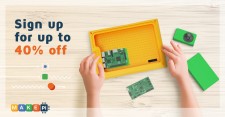MakePad is the First DIY Tablet Based on Raspberry Pi

SAN FRANCISCO, September 20, 2017 (Newswire.com) - Albeit very few students have had computer science lessons on an on-the-spot basis, the majority lacks access to both technical information and equipment, though. In spite of these restrictions, even those not-so-fortunate kids still find themselves emerged in a plethora of social networks, instant messaging and online-gaming. Paradox? Worse: Instead of learning how to think, children have been more inclined to mimic unfiltered and common-sense-web-based knowledge on daily basis. Even if you turn off your internet router, they will find a way around it.
Feeling uneased already? We are and we have been for a long time. That is the main reason why MakePi was born envisioning to cope with STEM’s teaching and learning processes. Let us walk you through all the features of our MakePad and share how we have designed, developed and implemented them to fulfill our founders’ vision.
1) 10.1” TOUCHSCREEN DISPLAY
MakePi developed a solution for a 10.1” touchscreen display that could be controlled and, thus, keeping all of RaspberryPi’s four USB ports free to be used with a lot of other peripherals. This solution will allow students to explore endless possibilities with their fingertips.
2) OPERATIONAL SYSTEM CUSTOMIZED FOR STEM EDUCATION
Based on Linux distribution Debian 9, MakePad’s OS (MakeOS) feels fun and fast. Customized toward a user-friendly perception, we have optimized its operations for touchscreen appliances. Nonetheless, it offers support for many peripherals since we have kept all USB and GPIO ports free to be used.
3) CHILDREN CAN ASSEMBLE THE TABLET WITH THEIR OWN HANDS
All the components can be easily assembled to the inner section of the tablet because of its tethering patterns. Except for the RaspberryPi’s, all the other circuits had to be customized for both functionality and user-friendly design. Children will understand how the hardware works altogether by connecting the cables and comprehending the logical sequence to power up the MakePad.
4) MOBILITY WITH A LITHIUM BATTERY OF 12-HOUR-AUTONOMY
Besides being equipped with a powerful battery, MakePad’s DIY concept allows children to easily replace it with additional units.
5) COGNITIVE COMPUTING APPLICATION
Inasmuch as AI drives technological platforms, likewise speech recognition, MakePi came up with one special application using IBM’s Watson technology. Children will be able to program MakePad’s make-mods functionality by voice. How cool is that?
6) RASPBERRYPI BASED HARDWARE
Do you remember our vision statement? We have chosen the RaspberryPi CPU because this solid, compact and powerful platform has brought computer science to a new democratization era. In order to cope with STEM’s teaching and learning processes, we could not have agreed more but to implement and share RaspberryPi’s possibilities with parents, teachers and children from all over the world.
7) NO INTERNET CONNECTION NEEDED FOR EDUCATIONAL PURPOSES
This is one of our favorites. If a device is mobile, why do children keep learning solely at their desks? To provide a truly untethered experience, we have embarked our Make-mods and Make-music applications into the MakeOS. Therefore, lack of network infrastructure around the world can be counteracted with this solution, specially at remote locations.
8) PROPRIETARY APPLICATIONS THAT ALLOW KIDS TO CREATE DIGITAL MUSIC WITH CODE
Here are the reasons why our slogan is “We Can Make…” First, we can make mods. Make-mod allows users to program modifications (mods) within the Minecraft virtual universe by applying Blocky language. Second, we can make music. Make-music is probably the world’s first appliance to use Blocky for digital music creation! Next… well, this will be up to you and your children. All they need is guidance and access to our MakePad.
9) OS AVAILABLE IN ENGLISH, SPANISH AND PORTUGUESE
Choose your language and embrace the future of STEM education.
About MakePi
MakePi is a startup that was born to empower learners, makers and educators. We have a background in STEM education and technology that comprises Happy Code's computer science teaching across the U.S., Latin America and Europe. Our dream is to make tech education possible for every child from all over the world with MakePad. By November, we will be launching MakePad on a crowdfunding platform. Follow us on this journey subscribing at makepi.com and help our children towards infinity and beyond.
Contact:
Marcos Oliveira
marcos.oliveira@makepi.com
www.makepi.com
Source: MakePi
